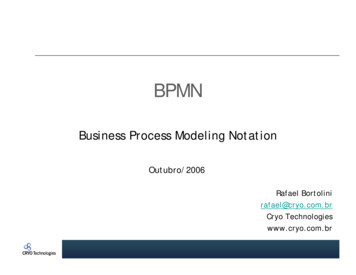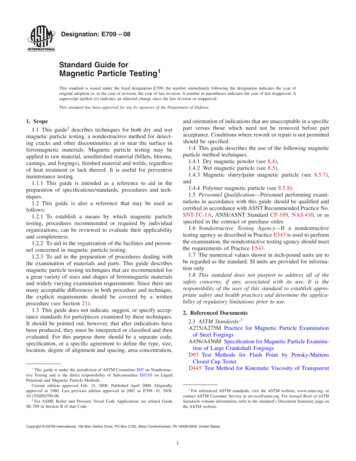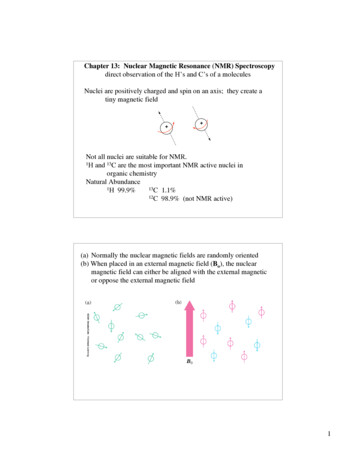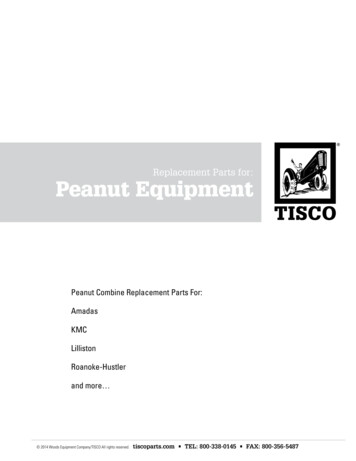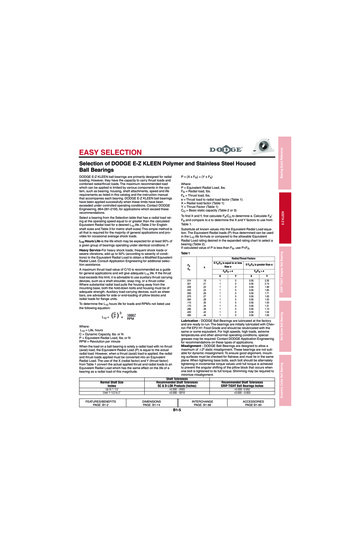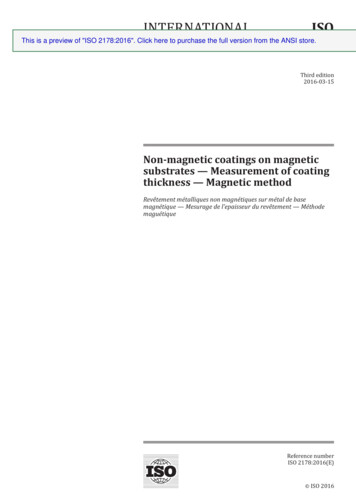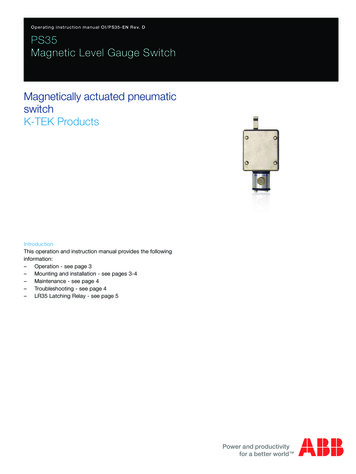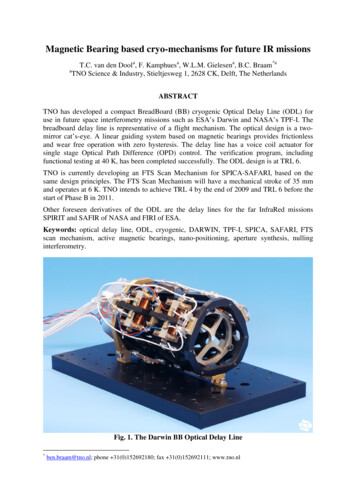
Transcription
Magnetic Bearing based cryo-mechanisms for future IR missionsT.C. van den Doola, F. Kamphuesa, W.L.M. Gielesena, B.C. Braam*aaTNO Science & Industry, Stieltjesweg 1, 2628 CK, Delft, The NetherlandsABSTRACTTNO has developed a compact BreadBoard (BB) cryogenic Optical Delay Line (ODL) foruse in future space interferometry missions such as ESA’s Darwin and NASA’s TPF-I. Thebreadboard delay line is representative of a flight mechanism. The optical design is a twomirror cat’s-eye. A linear guiding system based on magnetic bearings provides frictionlessand wear free operation with zero hysteresis. The delay line has a voice coil actuator forsingle stage Optical Path Difference (OPD) control. The verification program, includingfunctional testing at 40 K, has been completed successfully. The ODL design is at TRL 6.TNO is currently developing an FTS Scan Mechanism for SPICA-SAFARI, based on thesame design principles. The FTS Scan Mechanism will have a mechanical stroke of 35 mmand operates at 6 K. TNO intends to achieve TRL 4 by the end of 2009 and TRL 6 before thestart of Phase B in 2011.Other foreseen derivatives of the ODL are the delay lines for the far InfraRed missionsSPIRIT and SAFIR of NASA and FIRI of ESA.Keywords: optical delay line, ODL, cryogenic, DARWIN, TPF-I, SPICA, SAFARI, FTSscan mechanism, active magnetic bearings, nano-positioning, aperture synthesis, nullinginterferometry.Fig. 1. The Darwin BB Optical Delay Line*ben.braam@tno.nl; phone 31(0)152692180; fax 31(0)152692111; www.tno.nl
1. INTRODUCTION1.1 Darwin BB ODLTNO has developed a compact BreadBoard (BB) cryogenic Optical Delay Line (ODL) foruse in future space interferometry missions such as ESA’s Darwin [1] and NASA’s TPF-I.The design, implementation, and testing of these optical delay lines by TNO (see Figure 1)are described in this paper. Within the Darwin ODL BB project, the responsibilities weredivided as follows:- TNO: project management, systems engineering, optical design, OPD control, andintegration- Micromega-Dynamics: magnetic bearing guiding system development- SRON: actuator and power amplifier development and cryogenic consultancy- Centre Spatiale de Liege (CSL): coating engineering and 40K TV facility- Dutch Space: thermal modeling and development tests at 100 K- Alcatel Alenia Space: mission level consultancy and verification tests (with Sageis-CSO)The design of the delay line started in December 2003 [2]. The BB delay line was built in thesecond half of 2004. The manufacturing and assembly phase was followed by acomprehensive engineering test program in 2005, including functional testing at 100 K.Verification testing, including performance measurements at 40 K, was carried out in the firsthalf of 2006. The project was completed with a final presentation at ESTEC on 12 December2006. The ODL design is at TRL 6.1.2 SAFARI FTS Scan MechanismThe Space Infrared Telescope for Cosmology and Astrophysics (SPICA) is a 3.5-metertelescope actively cooled to below 5 K. The Japanese Aerospace Exploration Agency(JAXA) plans to launch SPICA into an Earth-Sun Lagrangian-point L2 orbit in 2017. Theproposed European instrument contribution to SPICA is the Spectrometer for Astronomy inthe Far Infrared (SAFARI). The SAFARI Phase A instrument study is done by a Europeanconsortium led by Rutherford Appleton Laboratory (RAL) in the UK [6]. SAFARI willperform high sensitivity imaging spectroscopy in the 35-210 µm band.TNO is currently developing an FTS Scan Mechanism for SPICA-SAFARI, based on theDarwin ODL design principles The FTS Scan Mechanism will have a mechanical stroke of35 mm and operates at 6 K. TNO intends to achieve TRL 4 by the end of 2009 and TRL 6before the start of Phase B in 2011. Within this study TNO works closely together with RALand former ODL partners Micromega-Dynamics and SRON:- TNO: project management, systems engineering, optical design, OPD control- Micromega-Dynamics: magnetic bearing guiding system development- SRON: actuator and power amplifier development and cryogenic consultancy
1.3 Other missionsOther foreseen derivatives of the ODL are the delay lines for the far InfraRed missionsSPIRIT and SAFIR of NASA and FIRI of ESA. References to the TNO ODL can be found inthe SPIRIT and SAFIR white papers.2. DARWIN ODL2.1 Design DescriptionThe main requirements for the Darwin ODL are [3]:-Optical beam diameter: 25 mmOPD stroke: 20 mm (10 mm mechanical)Dimensions: 300 x 100 x 100 mm3Mass: 10 kg (target: 6 kg)Space vibrations: 100nm rms (-40 dB/dec for f 1 Hz)OPD stability: 1 nm RMS (0.5 nm mechanical)Dynamic response: 25 µm step in 20 ms.Overall power dissipation: 2.5 WPower dissipation in ODL: 25 mWOutput beam tilt: 0.24 µradOutput beam lateral shift: 100 µmWavelength range: 0.45 - 20 µmWavefront distortion: 63 nm rmsRelative spectral response: 10e-4Chromatic phase differences: 0.1 nm rmsRelative polarization Rotation: 0.1 degRelative polarization Ellipticity: 0.1 degTransmission: 94% (4 to 20 µm wavelength)Operational temperature: 40KAmbient pressure: 10e-6 mbarQuasi static design load: /-45 gRandom vibration levels: 30 g RMSShock: 200 gDesign lifetime: 10 yearsThe basic structure of the ODL is arranged around a cat’s-eye with a focal length of 120 mm,which is determined by optimizing between overall size of the ODL and sensitivity toalignment and guiding errors (see Figure 2). Maintaining polarization of the incoming beamsis easier with a cat’s-eye than for instance with a corner cube. The use of a cat’s-eye wouldalso enable optional pupil imaging (currently not a requirement). However, the ODL designdoes not exclude the future use of a corner cube.
Fig. 2. LEFT: the optical design of the ODL is a cat’s-eye with a primary 63 mmparabolic mirror (M1) and a small 6 mm secondary mirror (M2). RIGHT:front view of the ODL with 25 mm science beam entrance and exit and 14mm metrology beam (optional).All parts of the main structure are manufactured out of a single piece of 6061-T6 aluminumto reduce thermal expansion differences when cooling down to the operational temperature of40 K. The mirrors are Alumiplated to reduce surface roughness after diamond turning (seeFigure 3). The use of Alumiplate prevents bimetallic bending of the mirrors at cryogenictemperatures. The design of the cat’s eye is fully athermal. Both mirrors are gold coated toobtain the required reflectivity in the mid infrared.Fig. 3. Inspection of the parabolic M1 mirror. The mirror is made of 6061-T6Aluminum, Alumiplated, diamond turned, and gold coated. The M1 mirrorsupport is a so called “wine-glass” type.A single stage OPD actuation scheme has been selected, which results in relatively lowoverall complexity. The power dissipation of a single stage is very low ( 1 mW at 40 K) andprovides the best optical performance (no focus errors of the cat’s-eye due to a piezo actuatedsecondary mirror).Magnetic Bearings (MBs) based on reluctance type electromagnets are used for the linearguiding mechanism (see Figure 4). The development was carried out by MicromegaDynamics and based on their experience in the MABE project [4]. MBs have no friction, nowear, require no lubrication and are simpler and more compact than flexures. Flexures wouldalso result in parasitic forces that complicate control and/or increase power consumption. TheMB design is double redundant; each yoke has 2 coils and each coil consists of 2 separatewindings. Five MB sets have been implemented but provisions have been added for a 6th MBcoil set for extra redundancy.
Fig. 4. Magnetic bearing design; LEFT: a soft iron moving target (horizontalbar) is retained in a non-stable equilibrium by 2 yokes (horse-shoes) withattracting permanent magnets (top and bottom). Four coils (squares aroundthe horse-shoes) and an appropriate controller with eddy current sensorsactively control the centre position. Five sets of bearings are used in the ODLto constrain five degrees of freedom. RIGHT: Close-up photograph of 2integrated magnetic bearing assemblies.For OPD actuation a fully redundant 2-coil Lorentz force motor is implemented (see Figure 5left). The design of this actuator is based on proven hardware, used for the ISO and HIFImissions (both for a cryogenic environment). This voice-coil actuator is mounted on thebackside of the parabolic M1 mirror through flexures such that thermal expansion differencesdo not influence the shape of the M1 mirror (see Figure 5 right). An ultra low noise currentamplifier with a large dynamic range powers the voice coil.The flight model of the ODL will need a launch lock. A launch lock was not part of thedevelopment program, but a simple manual lock for transport has been implemented.Otherwise the ODL has been fitted with all necessary provisions for a launch lock, such as a1200 N isostatic mount with 3 ball-grooves at the M2 side of the rotor.The ODL dynamic MB is equipped with a 1-g magnetic off-loading device, to enable groundtesting in horizontal position. In future a retraction mechanism will be required for it; this hasnot been implemented in the breadboard ODL. It is also possible to enlarge the MBssomewhat so that they can lift the mass of the rotor without the need for a separate magnet.At 40 K the MB power dissipation is very low anyway.Fig. 5. LEFT: CAD model of the OPD voice coil actuator. RIGHT: Rotor(moving part) design with parabolic mirror at the back. The magnet of thevoice-coil actuator is mounted on top of it through the flexure interface. Therotor has 6 flaps (4 visible) with soft iron magnetic bearing targets (black).The science and metrology beams are shown in transparent light blue.
Fig. 6. Complete ODL design with the rotor (moving part) inside the stator. Thevoice-coil is mounted on a separate cap on the back-side (shown on the left).The control of the magnetic bearings and the OPD was implemented on a real-time Linuxsystem with mostly commercially available components. The system was programmed fromSimulink and can be operated with either Matlab or Labview user interfaces. For a futureflight program it was verified that the control could be implemented in a low-power ( 2.5Watt) FPGA system. A breadboard low power FPGA controller has been developed withSRON in a NIVR sponsored program.The OPD control is based on loop-shaping techniques. This proved to be sufficient to obtainthe required sub-nanometer OPD stability, even in an earth environment with 10 fold higherenvironmental vibration levels than expected in a future Darwin mission. If needed, furtherimprovement or robustness against changes can be obtained with adaptive control [5].The OPD sensor (Fringe Sensor in DARWIN) was simulated by an Agilent laser metrologysystem with sub-nanometer resolution (0.3 nm) and a 10 kHz sampling rate. This has theadvantage that a large range of control bandwidths could be tested, e.g. to cope with a muchhigher disturbance spectrum during ground testing. A typical test setup is shown in figure 7.Fig. 7. Example of an ODL breadboard test set-up.
2.2 VERIFICATION PROGRAMA comprehensive development test program was carried out by TNO and SRON in 2005,preceding the verification phase. The development test program included deep thermalcycling of components and assemblies and operation of the ODL at 100 K in vacuum atDutch Space. OPD control algorithms were extensively tested under ambient conditions.Verification of the optical coating requirements of the mirrors was mainly done at samplelevel at ambient temperature by CSL. The coating tests included the following measurements:- Mirror surface roughness- Coating adhesion before and after thermal cycling- Optical transmission- Relative spectral response and chromatic phase differences- Relative polarization rotation and ellipticityAlcatel Alenia Space, in co-operation with Sageis-CSO, carried out the verification testprogram of the assembled ODL. It comprised an ambient test program and cryogenic testprograms at 120 K and 40 K. After completion of the ambient test program, the 120 K and 40K test programs were prepared and carried out at Dutch Space (Leiden, the Netherlands) andin the Focal 2 facility at the Centre Spatial de Liège (CSL, Belgium, figure 8).Fig. 8. Verification test setup in CSL’s Focal-2 thermal-vacuum facility in Liege,Belgium.2.3 PerformanceThe OPD stability during the 40 K TV test at CSL was between 5 and 10 nm rms (see Figure15). This is higher than the stability reached during the integration phase in the TNOlaboratories (0.9 nm rms), due to the higher disturbance spectrum of the TV facility ( 10xhigher than in the TNO laboratory at high frequencies between 50 Hz and 500 Hz).Based on these measurements, it has been calculated that an OPD error of better than 1 nmcan be achieved in the presumed Darwin spacecraft vibration environment, when the fringesensor sample rate is higher than 100 Hz. The sampling frequency during the verificationprogram was 10 kHz.
At 40 K the total power dissipation in the breadboard ODL was around 20 mW, mainly as theresult of heat leak through the cabling. For reasons of cost reduction, no special cryogenicharness was used for the Bread Board model. For the flight model, special cryogenic cablingwill be used, which will reduce the power dissipation through the cables to approximately 2mW and this will dominate the total power dissipation. The power dissipation in the magneticbearings at 40 K was measured to be 0.5 mW. This was due to the very low resistivity of thelow oxygen copper wire used. The power dissipation in the MB coils is very low becausethey areFig. 9. Open and closed loop OPD stability PSD (upper plot) and cumulative PSD(lower plot) during the 40 K TV test(-180 dB 1 nm2/Hz, -200 dB 0.01nm2/Hz, etc.).To further verify the beam tilt stability, the tilt of the rotor was measured (see Figure 10). Itproved to be in the order of 40 µrad, far better than the 400 µrad that it was designed for. Theeffect on the beam after going through the cat’s-eye was deduced from this figure to be farlower than the required 0.05 arcsec. It was also verified that the rotor tilt could be furtherreduced to 0.5 µrad with a lookup table for the magnetic bearing steering.
Fig. 10. Dynamic rotor tilt before and after active compensation with themagnetic bearings.The verification test program included Wave Front Error (WFE) measurements at ambienttemperature, at 120 K and at 40 K and for 3 field of view angles (0 and 3 arcmin). The finalWFE at ambient was better than approximately 20 nm lambda/30 rms for a beam diameterof 17 mm and all field of view angles.At cryogenic temperatures the WFE was somewhat larger than lambda/20 due to residualdifferential thermal contraction. This was corrected by adjusting the distance between the M1and M2 mirrors. The WFE does not depend on the OPD position of the ODL.3. SPICA-SAFARI FTS SCAN MECHANISMSPICA is a candidate for the ESA Cosmic Vision programme and sufficient TRL will have tobe demonstrated before September 2009, to ensure a favorable decision for the SPICAmission.SAFARI asks for a compact and lightweight mechanism with high scanning velocity andsmall position error. The operational temperature will be 6 K and power dissipation shall bebelow 1 mW. SAFARI will also require a low power internal cryogenic position sensor (sincethere is no Fringe Sensor like in Darwin). In addition SAFARI needs a re-usable lock forcertain observation modes. These are all significant deviations from the Darwin design andwill require partly new technology as well. During a technology review in 2008, ESA hasrecommended to use the Darwin ODL technology for the SAFARI FTS scan mechanism.TNO is currently developing an FTS Scan Mechanism for SPICA-SAFARI, based onmagnetic bearings. The FTS Scan Mechanism will have a mechanical stroke of 35 mm andoperates at 6 K. The use of magnetic bearings will result in a much compact mechanism withsmaller dimensions and mass compared to flexure based mechanisms. Due to the zero frictionand hysteresis of the magnetic bearings, the performance of the mechanism will exceed thatof similar flexure based mechanisms. A comparison of the SAFARI FTS Scan Mechanismrequirements and the Darwin ODL performance is given in table 1.
Beam diameterLinear strokeFTS Mirrors location accuracyFTS Mirrors location resolutionFTS mirrors velocitySpeed stabilityFTS Mirror accel-/decelerationMinimum stepSettling timeFTS mirror rotation (tip/tilt)FTS mirror lateral displacementScansMagnetic field emissionsStray light emissionsOperational temperaturePeak dissipationParasitic heat loadFTS Requirement (*)30 mm ?35 mm 15 nm [TBC] 5 nm30-500 (step 1) µm/s 2 um/s @ 0-20Hzwithin 0.5 mm 750 nm 200 ms [TBC] /-30 arcsec 100 µm150000 in flightTBWTBW4K 1 mW at 6 K (TBC) 300 µWDimensionsTBDMass 3 kg(*) Courtesy of Rutherford Appleton Laboratory (RAL)ODL Requirement25 mm 20 mm 0.5 nm 250 µm/s 0.5 nm 20 ms 50 µm 10-7 @ λ 4 mm.40 K 25 mW 100x100x300mm3 10 kgODL Measured27 mm20.2 mm 0.5 nm (RMS on earth) 0.1 nm0-10000 (step 0.1) µm/s 1 µm/s ( 0.5 nm RMS)within 0.005 mm 0.1 nm 20 ms 5 arcsec ( 0.5 optionally) 1 µmUnlimited 50 µT @ 10 cmNot verifiedtested at 25 K 1 mWTBD114 x 116 x 210 mm3 (no LL) 1.7 kgTable 1 comparison of SAFARI FTS Scan Mechanism requirements and Darwin ODLperformanceThe SAFARI FTS Scan Mechanism will require considerable development, including somenew technologies, like an ultra low power position sensor. TNO has identified a number ofdevelopment areas:–––––––––Optimization of optical layout and iteration with the instrument designLaunch Lock (a conceptual design study has already been carried out and an isostaticLL mount was implemented)Internal metrology sensor (e.g. ultra low power fiber interferometer)Behavior of magnetic and soft iron material (literature study)Cryogenic harness (first assessment shows that requirement is feasible)Design for failure tolerance / redundancyImplement “safe mode” (for instance combine with launch lock)Design for testing on earth (operation at 1g; by increasing MB coil size) and zero-gbehavior (e.g. influence on alignment and power dissipation)Low-power flight-electronics (ODELCO a prototype FPGA based controller wasdesigned by SRON, but not yet implemented).The preliminary design of the SAFARI FTS Scan Mechanism consists of a dual-corner cubestructure with a central voice coil actuator (figure 11). This configuration will be furtheroptimized during a number of design iterations in close cooperation with RAL and SRON.A Launch Lock design will be implemented.
Figure 11 MB based FTS Scan Mechanism with two corner cubesTNO intends to achieve TRL 4 by the end of 2009 and TRL 6 before the start of Phase B in2011.4. CONCLUSIONSTNO and its partners have demonstrated that accurate optical path length control is possiblewith the use of magnetic bearings and a single stage actuation concept. Active magneticbearings are contactless, have no friction or hysteresis, are wear free, and have a low powerdissipation. In combination with a two-mirror cat’s eye and a voice-coil actuator, themechanism is also compact with a low mass. The design of the Darwin BB ODL meets theESA requirements. The Darwin BB ODL is representative of a future flight mechanism, withall materials and processes used being suitable for flight qualification.A similar mechanism is under development for the SPICA SAFARI FTS Scan Mechanismand will meet or exceed current SAFARI requirements.5. ACKNOWLEDGEMENTThe work on the Darwin ODL has been performed under ESA contract 17.747/03, withsupport from the Netherlands's Agency for Aerospace Programs (NIVR), in preparation forthe DARWIN mission. TNO would like to thank Josep Maria Perdigues Armengol (ESAESTEC), Joost Carpay (NIVR), and Gustavo Vallejo (Alumiplate) for their support duringthe development of the delay line.
REFERENCES1. ESA-SciA, DARWIN Mission Summary Status, reference: SCI/AM/DARWINSUMSTAT/06, issue 2.0, rev.2, 19-2-2007.2. T.C. van den Dool et al, The design of a breadboard Cryogenic Optical Delay Line forDARWIN, SPIE Conference Astronomical Telescopes and Instrumentation Vol. 5495-40,June 2004, Glasgow, United Kingdom.3. Statement of Work, Optical Delay Lines, Programme Reference: TRP, ID-OP-12 TOSMMO/2002/276, issue 2.0, 6 March 2003 and clarifications 1, 2 and 3.4. MABE, Fine Precision Mechanism Based on Magnetic Bearing Technology, MicromegaDynamics – Executive Summary (ESA Contract No 13676/99/NL/PA)5. N.J. Doelman, T.C. van den Dool, Active Vibration Control for an Optical Delay Line,Proc. of Active 2002, pp.887-8986. The European contribution to the SPICA mission, Bruce Swinyard et al, SPIE 7010-17,SPIE Astronomical Telescopes and Instrumentation 2008, June 2008
Magnetic Bearing based cryo-mechanisms for future IR missions T.C. van den Dool a, F. Kamphues a, W.L.M. Gielesen a, B.C. Braam *a aTNO Science & Industry, Stieltjesweg 1, 2628 CK, Delft, The Netherlands ABSTRACT TNO has developed a compa
